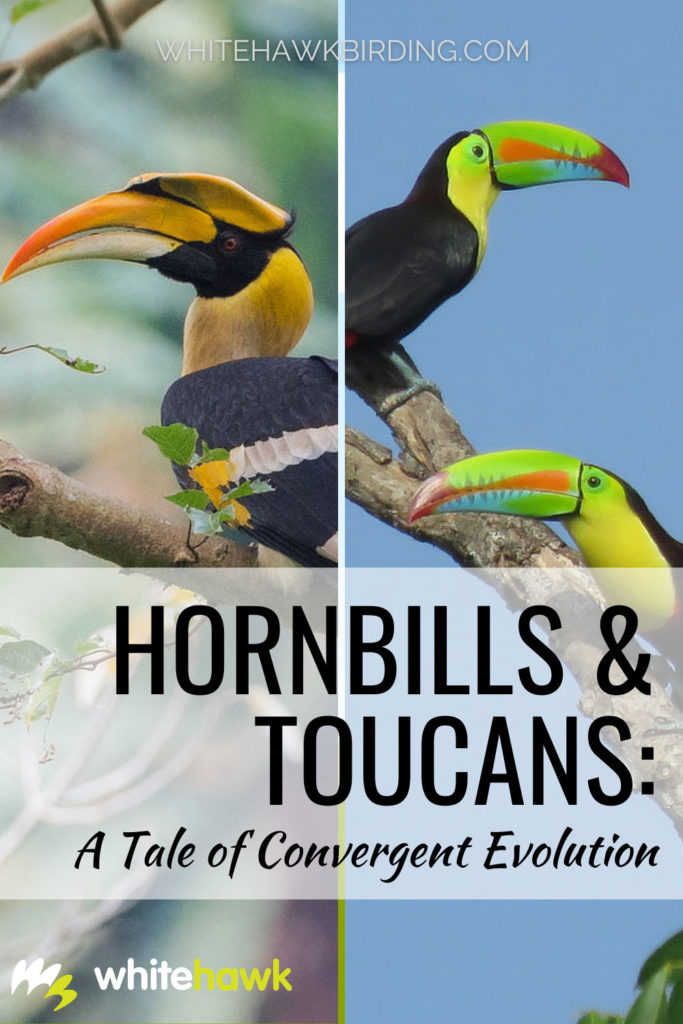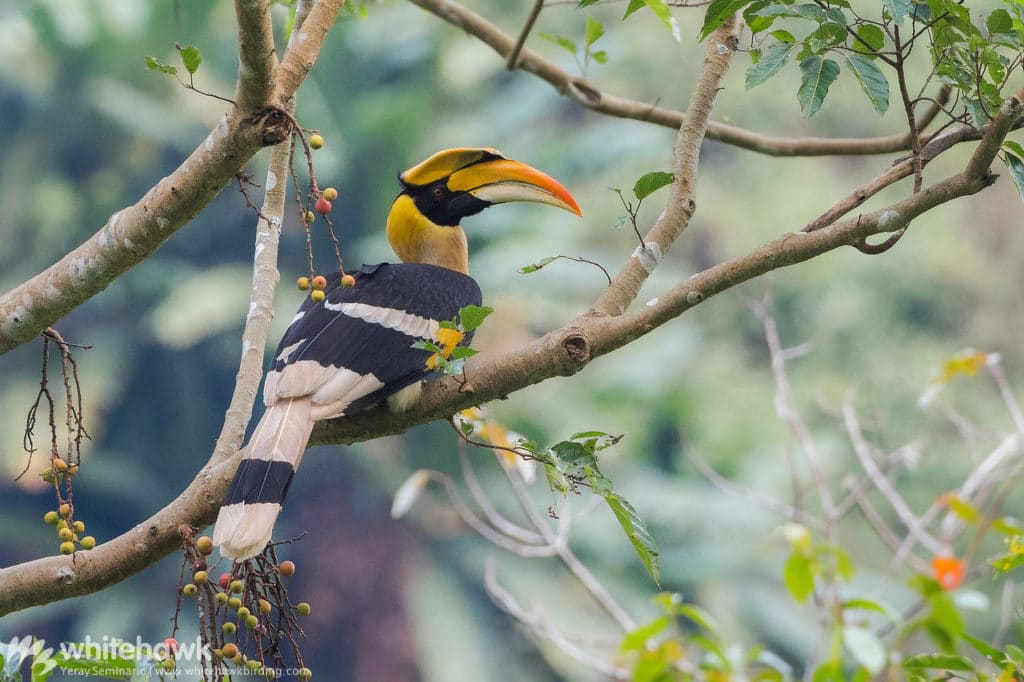
Hornbills and toucans are excellent examples of convergent evolution. Imagine yourself standing in a rainforest in Malaysia. The gigantic, towering trees overhead close the canopy providing you some appreciated shade from the strong tropical sun. Abundant vines and lianas drape over the large branches and circle tree trunks. Mosses, lichens, epiphytes and other plants blanket the forest understory with green. Drip tips and other leaf features tell you that you’re in a place that receives a great amount of rain throughout the year.
A chorus of birds and insects resound through the forest understory. You hear the unusual sounds made by monkeys and other rainforest mammals. Just then, a huge shadow swoops in and lands on a big branch above you. A large bird with a huge, down-curved bill looks down at you. It’s a Great Hornbill, an old world bird of the tropical forests of Asia and Africa.
Now, transport yourself to a rainforest in Central America, Panama to be precise. The structure of the forest is very much the same as in Malaysia, shaped by abiotic factors including sun, rain and soil composition. But something’s different – the chorus of birds sounds unlike that of the Indonesian rainforest. Virtually all species are different here. Howler Monkeys, a species found only in the Neotropics, bellow from the treetops. You see a similar shadow fly overhead, and a bird comes into view. It also has a large, down-curved bill and same overall body structure as the hornbill, but it isn’t a hornbill at all. It’s a toucan – a Yellow-throated Toucan to be exact, the largest species of toucan found in Central America.
Convergent Evolution
Hornbills and toucans look incredibly similar. They have characteristic, distinct bills adapted for reaching fruits and probing into tree cavities. Wide, short wings are ideal for flight under the forest canopy. They have a long tail used as a rudder, to further assist with flight and quickly changing direction in the forest understory. Both hornbills and toucans have predominantly black and white plumage in general with contrasting brightly colored beaks and rumps. Both hornbills and toucans nest in tree cavities. However, despite these similar characteristics and adaptations, they aren’t closely related. They do not even come close to overlapping in range. Both hornbills and toucans have evolved to fill the same ecological niche, in different parts of the world, and thus have developed the same characteristics for survival. This is called convergent evolution.
Hornbill Characteristics
Hornbills are are as unmistakeable as they are beautiful. Though their feathers lack some of the brighter colors we come to expect from tropical species, their more muted feather patterns of black, white, brown or grey are actually quite lovely. Besides, their brightly colored bills and bare skin patches (on some species) do not disappoint. Of course, we can most easily distinguish hornbills by their large, protruding bills. Though it might seem cumbersome to fly and feed with such a large beak, hornbills are specially adapted to do just that. The first two vertebrae in their necks are fused, a trait unique to this group of birds. Scientists believe this is to provide greater stabilization of the neck. Their binocular vision allows them to see the tips of their bills, which may help them more precisely grab and handle their food.
Hornbills are omnivorous. They feed on a number of different types of fruits and small animals. They nest in tree cavities and are believed to be monogamous. Scientists have identified 61 species of hornbills. Members of the Bucerotidae family, they are distributed mainly throughout parts of sub-Saharan Africa and Asia. However, no genus is found in both Africa and Asia.
Hornbills of Asia
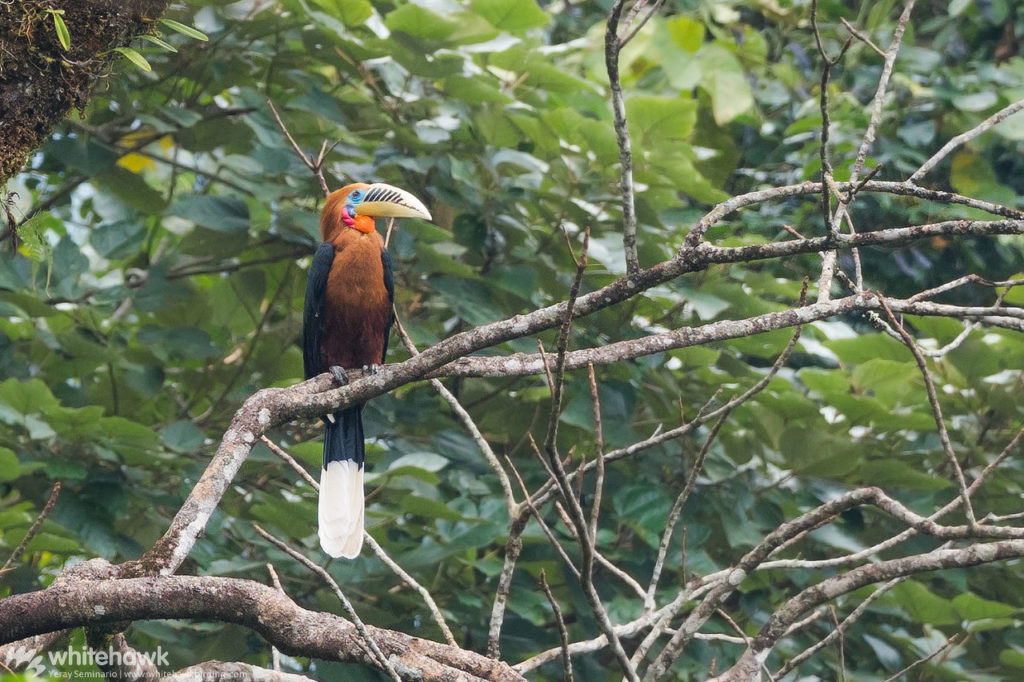
The hornbills of Asia are mainly forest-dwelling species. Like all hornbills, the species in Asia are diurnal and often fly or perch together in pairs or small family groups. India is home to 9 species of hornbills. One of the most common is the Indian Gray Hornbill. As its name implies, this medium-sized species is covered almost entirely in gray feathers. The neighboring island of Sri Lanka boasts an endemic hornbill, the Sri Lanka Gray Hornbill. For any birding trip to Bhutan, finding hornbills will be high up on the list. Some spectacular ones make their homes here including Rufous-necked Hornbill and Great Hornbill.
Hornbills of Africa
We can find roughly 24 species of hornbills on the continent of Africa. Of these, two are ground-dwelling species. Ground-hornbills are generally large, with adults growing to over 1 meter tall. They still share the same large bill and overall appearance of hornbills, but have long legs and compact toes for life adapted on the ground. Ground-hornbills belong to the Bucovidae family, and includes Abyssinian and Southern ground-hornbills. They live exclusively in sub-Saharan Africa. Researchers believe they are mostly carnivorous.
When we think of hornbills we also might think of lush forests. However, more than 10 species of hornbills on the African continent prefer open woodlands and savannas. One of the most common and widespread of the hornbills found on this continent is the African Gray Hornbill. Though it would be considered a medium-sized bird, it is actually on the smaller side for hornbills.
Toucan Characteristics
We can find toucans throughout the Neotropics, from southern Mexico to northern Argentina. There are more than 35 species of the family Ramphastidae, which include toucans, toucanets and aracaris. Like hornbills, toucans are best known and recognized by their large, colorful bills. In fact, some species’ bills can measure greater than half the length of their bodies. However, despite their cumbersome appearance, toucan bills aren’t very heavy at all. They are filled with keratin, which is the same material as our fingernails. They are highly vascularized, and assist with thermoregulation. Toucan bills have serrated edges which help them grasp their food more easily. While toucans are mainly frugivorous (fruit-eating), they will also feed on insects, lizards and even eggs and nestlings of other birds.
The large toucans of the genus Ramphastos are generally classified into “croakers” and “yelpers,” referring to their calls. They perch high in the forest canopy so these unusual calls carry for long distances. They are a familiar sound of the Neotropical rainforests. For example, the Keel-billed Toucan alerts us to its presence by making strange “croaking” calls. For many visitors, particularly those from North America, this call is reminiscent of a frog!
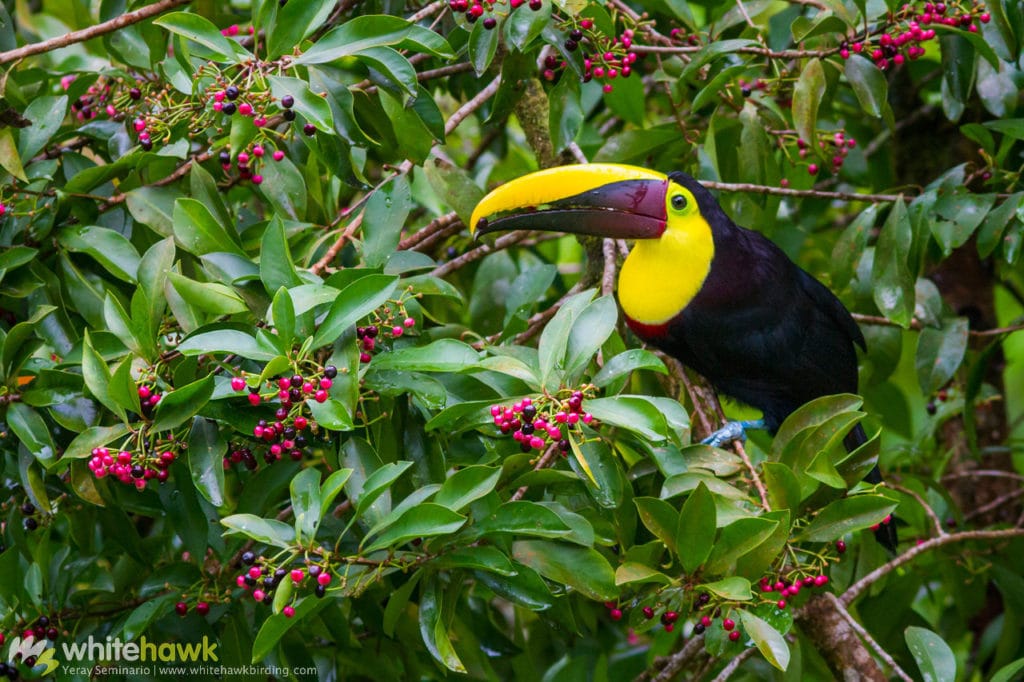
Toucans in Central America
Central America is home to 6 species of toucans. Whitehawk’s home base – Panama – is one of the best places to see toucans. In the Panama Canal area, perhaps the easiest species to see is the Keel-billed Toucan. This bird has a rainbow-colored bill and bright yellow throat. They often travel in groups of 4-5 and, if you are lucky, you may see them perched high up in snags, their bright bodies standing out against the blue sky.
Two other species of toucans frequent the Panama Canal Zone. The Yellow-throated Toucan is the largest of our toucans, and is as equally as noisy as the Keel-billed Toucan. The Collared Aracari is a medium-sized toucan, and is common throughout Central America. Look for all three species on Pipeline Road. The observation tower at the Panama Rainforest Discovery Center is a great place to scan for toucans. Traveling to the foothills of western Panama, we can hope to see the Northern Emerald-Toucanet and a visit to Cerro Azul might reward us with a sighting of the lovely Yellow-eared Toucanet. To see the Fiery-billed Aracari, we must travel to Panama’s westernmost province, Chiriqui. Here, this beautiful species inhabits lush foothills shared with Costa Rica.
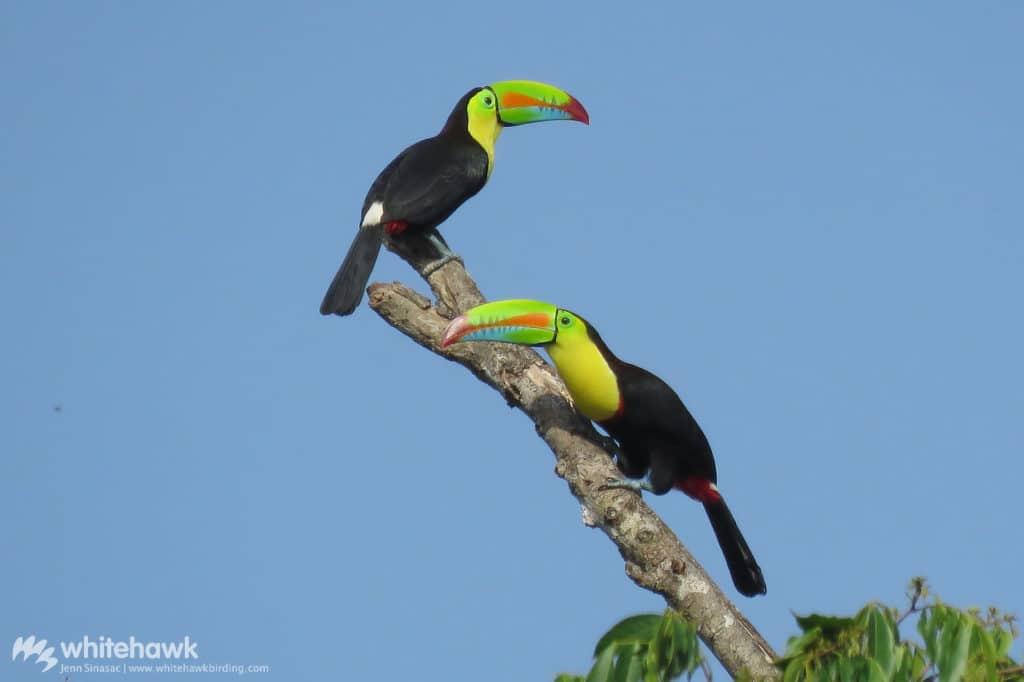
Toucans of South America
Toucans are more numerous in terms of species in South America. We can find them in forest and semi-open areas from the lowlands to the high cloud forest of the Andes. Six species live in the Colombian Andes. Changes in altitude bring us into the habitats of some higher-elevation species including Southern Emerald-Toucanet, Black-billed and Gray-breasted mountain-toucans.
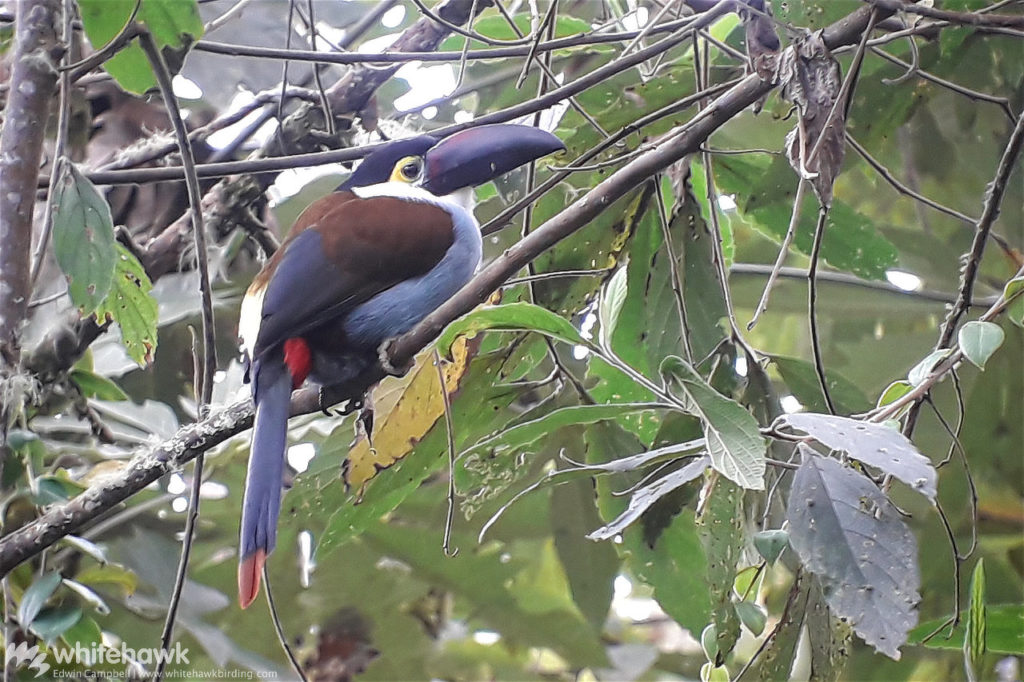
In the Amazon basin, around 15 species of toucans, toucanets and aracaris can be found. Some of the most notable toucans of the vast Amazon include Chestnut-eared and Curl-crested aracaris, Golden-collared Toucanet, White-throated Toucan, and the largest species, the Toco Toucan.
It’s fascinating to look at hornbills and toucans, their unique characteristics and remarkable similarities. Convergent evolution shows us just how important a role these birds play in their tropical environments. Next time you’re standing in a rainforest, whether in Malaysia or Panama, be sure to keep an eye out for these beaky beauties. Ask us about seeing toucans and hornbills on our tours!
~ The Whitehawk Team

